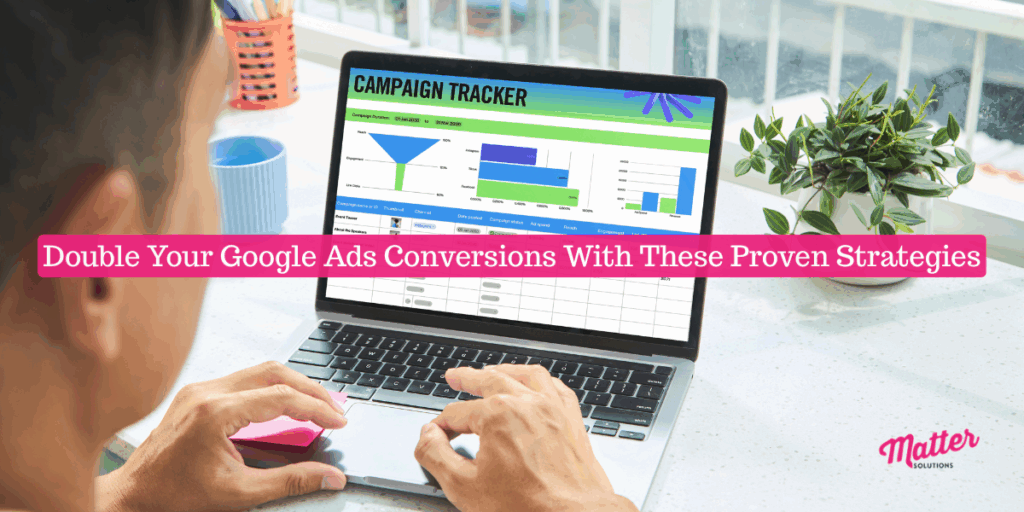Your Google Ads campaign isn’t converting because of targeting mismatches, weak landing pages, poor ad quality scores, or broken conversion tracking. Also, sending the right people to the wrong page or the wrong people to the right page is the most common culprit.
We’ve helped dozens of trade businesses over 15 years fix these exact problems at Matter Solutions.
In this article, we’ll share our insider strategies for diagnosing and solving the Google Ads conversion problems. You’ll get a complete breakdown on:
- What makes a good conversion rate, and how to spot fake metrics
- How to fix broken conversion tracking that kills optimization
- Landing page mistakes that lose customers after they click
- Quality Score improvements that lower your costs
- Audience targeting adjustments that find profitable customers
Keep reading to learn the specific fixes that saved our clients thousands in wasted ad spend.
The Common Conversion Issues Your Campaign Faces
Your Google Ads campaign faces some common conversion problems like mismatched audience targeting, weak landing page experiences, poor ad copy alignment, and broken tracking setups.

What makes these issues so damaging is how they create a disconnect between what your ads promise and what visitors find when they click through. When you prioritize clicks over conversions, you end up draining your marketing budget faster than you can say “cost per click.”
Here are the two major signs that your campaign needs immediate attention:
What’s a Good Google Ads Average Conversion Rate?
When your average conversion rate hits between 2% and 5%, that’s usually a sign your Google Ads campaign is performing well. The catch here is that your average conversion rate depends heavily on your industry and what you’re trying to achieve with your marketing budget.
One great example of this is high-ticket trade services. If you’re selling expensive contractor work, a 2% conversion rate might generate excellent profits. But if you’re offering lower-cost products like plumbing supplies or basic maintenance services, you’ll need higher rates to make the numbers work for your business.
The easiest way to calculate conversion rate is to divide your conversions by your clicks. Let’s say you got 50 conversions from 2,500 clicks. That gives you a 2% conversion rate (50 ÷ 2,500 = 0.02 or 2%).
Also, you can use Google’s conversion rate calculator to track campaign performance automatically without doing the math yourself.
Signs that Your Campaign Performance Metrics Are Lying to You
Just looking at clicks and impressions is like only reading the first page of a book. Your key metrics might show healthy click-through rate numbers, but if your total ad spend isn’t generating customers, your paid ads setup has issues.
What happens next is where most businesses get fooled by their own data. The problem with surface-level metrics is that high engagement numbers can mask serious issues in your campaign data. So when you dig deeper into your ad group performance, you’ll often find that those impressive stats don’t translate to actual sales.
Pro Tip: Check your campaign data at the ad group level weekly. High clicks with low conversions usually mean your ads attract the wrong people or send them to the wrong place.
Once you spot these red flags in your metrics, the next step involves getting technical. This is where you start digging into the specific mechanics of your Google Ads optimization system to find the problems.
The Technical Side of Google Ads Optimization
Now that you know how to spot the warning signs in your metrics, let’s fix the technical problems that are killing your conversions.
We’ve dealt with many business owners who feel overwhelmed when they hear “technical optimization”. Don’t worry. We’ve got it for you.
In this section, we’ll walk you through the most important fixes that increase your conversion rates and reduce wasted ad spend on your campaign performance.
Fixing Conversion Rate Tracking Problems
If you can’t track conversions, you can’t optimize. It’s that simple.
This is exactly why you need proper conversion rate tracking to do any effective Google Ads optimization. When your tracking is broken, you’re flying blind and making decisions based on incomplete data from your Google Ads account. The outcome of broken tracking is wasted ad spend and missed opportunities to identify what works.
For better results, try fixing these common setup issues in your Google Ads account:
- Enable auto-tagging in account settings
- Install Google Ads conversion linker tag
- Fix missing GCLID parameters completely
- Connect Google Analytics goals properly
When these tracking fixes are in place, you’ll immediately see which keywords and landing page combinations generate customers instead of just clicks. That’s the kind of clarity every business owner wants when they’re spending money on ads.
Optimizing Your Website and Landing Page
What’s the first thing people see when they click your ad? It’s your landing page, and this single page determines whether that expensive click becomes a paying customer or just another bounce.

The connection between your ad and landing page makes or breaks your conversion rate. If these two pieces don’t match perfectly, visitors will leave faster than they arrived. That means, when someone searches for “emergency plumber,” they shouldn’t land on your homepage with information about kitchen remodeling.
(Trust us, we’ve seen this happen more times than we can count!)
We suggest keeping your landing page focused on one service and one clear action. This approach helps you avoid confusing visitors with too many choices, which is exactly what kills conversion rates.
After you get these technical foundations working properly, you can start making strategic changes that multiply your results. Let’s see how basic adjustments in your approach can double your conversion numbers without spending more on ads.
Strategic Changes to Boost Conversions
If you want to boost conversions for your Google Ads campaign, then focus on improving your Quality Score, auditing your audience, and finding profit gaps. These changes focus on connecting your ads with the right audience while improving how Google sees your campaign quality.
The best part is that most of these adjustments take less than an hour to implement, but can double your results within weeks.
Now let’s walk through each strategy and show you how to put them to work for your business:
Improving Ad Relevance with Quality Score
A strong Quality Score directly lowers your cost per click (CPC) while improving your position in search results. The way it works is simple. When Google sees that your ad copy matches your keywords and your click-through rate stays healthy, they reward you with better placement and cheaper clicks.
What you need to do next is focus on writing ad copy that uses the exact keywords people search for. Once you make this change, you’ll watch your Quality Score climb while your bid amounts stay the same.
Audit Your Audience and Targeting
Are you talking to the right audience? The only way to know for sure is to dig into your campaign data. So, pull your campaign report and look at which keywords bring conversions versus which ones just burn budget.
If you can identify the winners and losers, add negative keywords for searches that don’t match your services. Then increase bid amounts on keywords that generate customers by raising them 20-30% above your average. When you target the right audience with precise keywords, your conversion rates improve automatically.
Think of it like fishing with the right bait in the right pond instead of casting a wide net everywhere.
How to Optimize for Profit and Revenue
To optimize for maximum profit, focus on keywords where your competitors miss opportunities in search results.
What this means is looking for high-converting keywords with lower competition, where you can get better ad placement without paying premium cost per click rates. This approach helps you capture more qualified traffic while your competitors fight over expensive, crowded keywords.
We once helped a garage door company increase its conversions by 180% just by switching its ad copy to match exactly what homeowners typed into Google. Their click-through rate jumped from 2.1% to 4.8% within three weeks. Finally, they could stop competing on price and start winning on relevance instead.
Stop Wasting Ad Spend on Broken Campaigns
Poor Google Ads conversion rates drain budgets and frustrate business owners who watch clicks disappear without generating customers. However, the problem isn’t complex, and proven solutions exist for you to fix these expensive mistakes.
We’ve covered conversion tracking setup, landing page optimization, Quality Score improvement, audience targeting audits, and profit-focused keyword strategies. These fixes address the root causes that separate successful campaigns from failed ones.
Your Google Ads can generate consistent profits with the right approach. If you need experts to handle your campaign optimization, our team is always ready to help.


